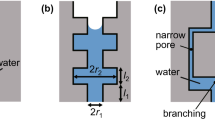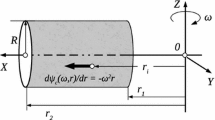Abstract
The kinetics of capillary imbibition into sedimentary rocks has been measured experimentally and calculated with a model that has been described previously by Hammecker and colleagues (1993). The validity of this model has been discussed and compared to other models. Three limestones, two clean sandstones and three clayey sandstones have been studied. The capillary processes are discussed as a function of their petrography and the pore structures. The role of the grain surface, described by the specific surface area, has been especially studied. The influence of clay coating on detrital grains on capillary processes has been quantified.
Similar content being viewed by others
Abbreviations
- A :
-
weight increase rate by capillary imbibition (A=ΔW/(S 1√t))
- B :
-
capillary rise rate (B=Δl/√t)
- l :
-
height of the capillary fringe or the meniscus over the free water level
- g :
-
gravitational constant
- L :
-
height of the geometrical elements
- P a :
-
pressure in the air
- P c :
-
capillary pressure
- P w :
-
pressure in the water
- Q :
-
flow rate
- N l :
-
free porosity
- Nt :
-
total porosity
- r :
-
radius of the pore (meniscus)
- r 1 :
-
pore access radius (neck)
- R :
-
pore radius (widening)
- R s :
-
particle radius
- S :
-
specific surface area
- S 1 :
-
macroscopical area of the sample surface throughout which imbibition occurs
- t :
-
time
- W :
-
weight
- z :
-
height
- γ :
-
surface tension
- η :
-
dynamic viscosity
- θ :
-
contact angle
- ρ :
-
density
- ρ r :
-
true density
References
Amoroso, G. G. and Fassina, V.: 1983, inStone Decay and Conservation, Materials Science Monographs, 1, Elsevier, Amsterdam, pp. 12–42.
Chatzis, I. and Dullien, F. A. L.: 1981, Mercury porosimetry curves of sandstones, Mechanisms of mercury penetration and withdrawal,Powder Technol. 29, 117–125.
Dullien, F. A. L.: 1979,Porous Media: Fluid Transport and Pore Structure, Academic Press, New York, pp. 291–300.
Dullien, F. A. L.: 1981, Wood's metal porosimetry and it's relation to mercury porosimetry,Powder Technol. 29, 109–116.
Dullien, F. A. L., El-Sayed, M. S., and Batra, V. K.: 1977, Rate of capillary rise in porous media with non uniform pores,J. Colloids Interface Sci. 60, 497–506.
Good, R. J. and Mikhail, R. S.: 1981, The contact angle in mercury porosimetry,Powder Technol. 29, 53–62.
Graton, L. C. and Fraser, H. J.: 1935, Systematic packing of spheres with particular relation to porosity and permeability,J. Geology 43(8), 785–909.
Hammecker, C.: 1993, Importance des transferts d'eau dans la dégradation des pierres en œuvre, Thèse Univ. Louis Pasteur, Strasbourg.
Hammecker, C., Mertz, J. D., Fischer, C., and Jeannette, D.: 1993, A geometrical model for numerical simulation of capillary imbibition in sedimentary rocks,Transport in Porous Media 12, 125–141.
Jeannette, D. and Hammecker, C.: 1993, Importance des structures de porosité dans l'altération des pierres des monuments, Coll. de l'Académie des Sciences et du Cadas “Sédimentologie et Géochimie de la Surface” à la mém. de G. Millot, 27 et 28 Avril, pp. 307–319.
Mertz, J. D.: 1991, Structures de porosité et propriétés de transport dans les grès, Sci. Géol Mém. 90, 149 pp.
Kusakov, M. M. and Nekrasov, D. N.:1966, Capillary hysteresis in the rise of wetting liquids in single capillaries and porous bodies, in B. V. Deryagin (ed),Research in Surface forces, New York, pp. 193–202.
Levine, S., Lowndes, J., and Reed, P.: 1980, Two-phase fluid flow and hysteresis in a periodic capillary tube,J. Colloid Interface Sci. 77, 253–263.
Lewin, S. Z. and Charola, A. E.: 1979, The physical chemistry of deteriorated brick and its impregnation techniques, inAtti del Convegno Internazionale Il Mattone di Venezia, Venice, October 22–23, pp.189–214.
Marmur, A.: 1989, Capillary rise and hysteresis in periodic porous media,J. Colloid Interface Sci. 127, 362–372.
Meunier, J. D.: 1992, Precipitation of minerals between detrital quartz and quartz overgrowths in sandstones,Eur. J. Mineral. 4, 1401–1406.
Pittman, E. D.: 1972, Diagenesis of quartz sandstones as revealed by scanning electron microscopy,J. Sed. Petrology 42(3), 507–519.
Szekely, J., Neumann, A. W., and Chuang, Y. K.: 1971, The rate of capillary penetration and the applicability of the Washburn equation,J. Colloid Interface Sci. 35, 273–283.
van Brakel, J.: 1975, Pore space models for transport phenomena in porous media. Review and evaluation with special emphasis on capillary transport,Powder Technol. 11, 205–236.
van Olphen, H. and Fripiat, J. J.: 1979,Data handbook for clay materials and other non metallic minerals, Pergamon, London.
Washburn, E. W.: 1921, The dynamics of capillary flow,Phys. Rev. 17, 273–283.
Zinszner, B. and Meynot, C.: 1982, Visualisation des propriétés capillaires des roches réservoirs,Rev. Inst. Franç, du Pétrole 37, 337–361.
Author information
Authors and Affiliations
Rights and permissions
About this article
Cite this article
Hammecker, C., Jeannette, D. Modelling the capillary imbibition kinetics in sedimentary rocks: Role of petrographical features. Transp Porous Med 17, 285–303 (1994). https://doi.org/10.1007/BF00613588
Received:
Revised:
Issue Date:
DOI: https://doi.org/10.1007/BF00613588




